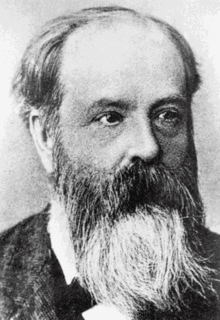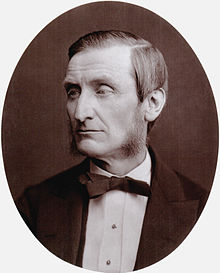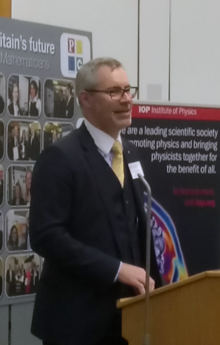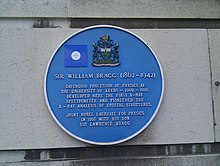Institute of Physics
CBE | |
Key people | Tom Grinyer (CEO) Antonia Seymour (CEO IOP Publishing)[2] |
|---|---|
Budget | £72 million[3] |
Staff | 556 (2018)[4] |
| Website | www |
The Institute of Physics (IOP) is a UK-based
It was founded in 1874 and has a worldwide membership of over 20,000.[6] The IOP is the Physical Society for the UK and Ireland and supports physics in education, research and industry.[7] In addition to this, the IOP provides services to its members including careers advice and professional development and grants the professional qualification of Chartered Physicist (CPhys), as well as Chartered Engineer (CEng) as a nominated body of the Engineering Council.[8] The IOP's publishing company, IOP Publishing, publishes 85 academic titles.[9]
History




The Institute of Physics was formed in 1960 from the merger of the Physical Society, founded as the Physical Society of London in 1874, and the Institute of Physics, founded in 1918.[10][11]
The Physical Society of London had been officially formed on 14 February 1874 by
In the early part of the 20th century, the profession of "
In 1932, the Physical Society of London merged with the Optical Society to create the Physical Society. In 1960, the Physical Society and the Institute of Physics merged, creating a single organization with the name The Institute of Physics and the Physical Society, with John Cockcroft elected at its first president. The new society combined the
Membership
The IOP has 23,000 members
These four grades of membership replaced the previous seven grades in January 2018; these changes introduced removed affiliate memberships for undergraduates (they are now Associate Members), removed the post-nominal letters AMInstP, and made Associate Members voting members.[18] In 2015, the membership of the Institute of Physics was 86% male at MInstP and 91% male at FInstP. 85% of Honorary Fellows were male.[19]
The institute grants
Professional qualifications
The institute grants the
Education
The IOP accredits undergraduate degrees (BSc/BA and MSci/MPhys) in physics in British and Irish universities.
In March 2019, the Institute of Physics launched the Bell Burnell Graduate Scholarship Fund with the goal of helping female and black students to become physics researchers. The program is funded by
The institute is also interested in the ethical impact of physics, as is witnessed though the Physics and Ethics Education Project.[35]
Publishing
IOP Publishing is a wholly owned subsidiary of the IOP that publishes 85 academic titles.
Governance

An elected Council governs and controls the affairs of the institute.[36] The council meets four times a year and has up to 21 members, of whom 18 are elected by members of the institute.
The president is elected by the membership of the institute and serves a term of two years. The current president is
Coat of arms

The IOP has its own coat of arms, granted in 1994. The arms feature a shield bearing a representation of an atom, and the organisation's motto "Intellegite et explicate" ("Understand and explain"). Presidents of the IOP wear a medal featuring the coat of arms at formal occasions.[10]
Awards
The institute awards numerous prizes to acknowledge contributions to physics research, education and application.[39]
Headquarters

Since its formation, the institute has had its headquarters in London. The early meetings of the Physical Society of London were hosted in
In 2013, the IOP bought a property in
See also
References
- ^ "Letter to the Prime Minister" (PDF). Institute of Physics. Archived from the original (PDF) on 27 December 2019. Retrieved 27 December 2019.
- ^ "Antonia Seymour, Chief Executive, IOP Publishing".
- ^ "Data for financial year ending 31 December 2018 – The Institute Of Physics". Chairty Commission. Retrieved 28 December 2019.
- ^ "Annual Report of the IOP 2018 pp60" (PDF). Archived from the original (PDF) on 28 December 2019. Retrieved 28 December 2019.
- ^ "About us". Institute of Physics. Retrieved 28 December 2019.
- ^ "Letter to the Prime Minister" (PDF). Institute of Physics. Archived from the original (PDF) on 27 December 2019. Retrieved 27 December 2019.
- ^ Institute of Physics Policy Activities
- ^ Becoming Chartered by the Institute
- ^ a b "Our mission". IOP Publishing. Retrieved 29 December 2019.
- ^ ISBN 0-7503-0879-6
- .
- ^ a b c d e f "The History of the Institute". History. Institute of Physics and IOP Publishing. 2009. Retrieved 2009-08-25.
- ^ "Sir Richard Tetley Glazebrook". National Physical Laboratory. Archived from the original on 30 March 2012. Retrieved 12 January 2019.
- ^ About Us: Early History of IOP in Ireland Foundation of the Irish branch
- ^ "Institute of Physics Charter and Bylaws" (PDF). Archived from the original (PDF) on 3 December 2013. Retrieved 29 December 2019.
- ^ "Letter to the Prime Minister" (PDF). Institute of Physics. Archived from the original (PDF) on 27 December 2019. Retrieved 27 December 2019.
- ^ a b "Register of Accredited Courses" (PDF). IOP. July 2022. Retrieved 19 June 2023.
- ^ "Summary of changes to the membership structure". Institute of Physics. Retrieved 12 January 2018.
- ^ "What does a physicist look like?" (PDF). IOP. Archived from the original (PDF) on 31 December 2019. Retrieved 29 December 2019.
- ^ a b "Misc robes". Archived from the original on 2013-05-28. Retrieved 2011-02-19.
- ^ Specifications on the IoP website are in cm; Burgon Society publications give specifications in inches
- ISBN 978-099287400-1.
- ^ "Academic Dress". Institute of Physics. Retrieved 20 October 2016.[permanent dead link]
- ^ "IOP licensed to award professional registrations". Institute of Physics. 20 May 2016. Retrieved 20 October 2016.
- ^ "Professional registration". Institute of Physics. Retrieved 29 December 2019.
- ^ "Charter and Bylaws" (PDF). Institute of Physics. Bylaw 7. Archived from the original (PDF) on 11 April 2019. Retrieved 26 December 2019.
- ^ "Charter and Bylaws" (PDF). Institute of Physics. Archived from the original (PDF) on 3 December 2013. Retrieved 12 December 2016.
- ^ "Chartered Physicist (CPhys)". Institute of Physics. Retrieved 29 December 2019.
- ^ "Guidance on maintaining your CPhys". Institute of Physics. Retrieved 26 December 2019.
- ^ "Letter to Advancing Physics users". Archived from the original on 2011-08-11. Retrieved 2011-01-25.
- ^ "Integrated Sciences". Archived from the original on 2008-07-17. Retrieved 2008-09-03.
- ^ Stimulating Physics Network Archived 2015-02-16 at the Wayback Machine
- ^ "IOP Teacher Training Scholarships". Institute of Physics.
- ^ Ghosh, Pallab (19 March 2019). "Fund to boost female and black physicist numbers". BBC News. Archived from the original on 21 March 2019.
- ^ "PEEP Physics Ethics Education Project: Teaching controversial and social issues in science / Physics".
- ^ "IOP Governance". Institute of Physics. Retrieved 2019-12-27.
- ^ "IOP Council". IOP. Retrieved 2021-10-09.
- ^ "New Chief Executive for the Institute of Physics". Retrieved 19 December 2019.
- ^ "IOP awards". Institute of Physics. Retrieved 20 December 2019.
- ^ "A new home for physics community in King's Cross". Institute of PHysics. 10 October 2013. Archived from the original on 16 August 2014.
- ^ Brigstock-Barron, Rory (12 December 2014). "Row over plans for Institute of Physics building in King's Cross". Islington Gazette. Archived from the original on 30 March 2019. Retrieved 5 December 2015.
- ^ "Residents take apart Institute of Physics case on eve of planning meeting". Kings Cross Local Environment. 2015-02-05. Archived from the original on 2022-04-07. Retrieved 5 December 2015.
- ^ "We moved to King's Cross on Monday 29 October". Institute of Physics. Archived from the original on 9 December 2018. Retrieved 8 December 2018.
External links
- Official website

- IOP Science journal articles
- IOP Publishing
- Physics World
- Explore Physics online guide
